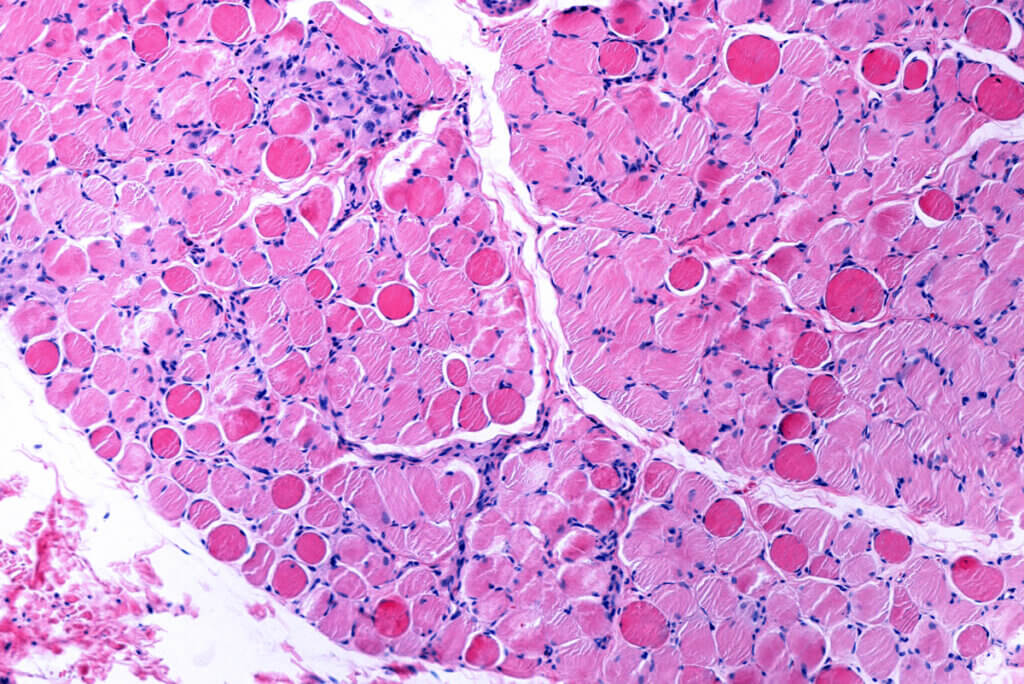Properties and Benefits of Leucine


Escrito y verificado por el nutricionista Saúl Sánchez
Leucine is one of the essential amino acids that make up proteins. Like all the others, in addition to being part of more complex structures, it has a series of specific functions. Let’s take a look at the benefits of leucine.
Before we begin, we must highlight the importance of consuming foods of animal origin and plant origin. Both contain protein, but of different quality. They can be complemented, but they shouldn’t be replaced, since this could generate inefficiencies in the functioning of the organism.
Essential and non-essential amino acids
Essential amino acids are those that the human body cannot manufacture on its own. For this reason, they must be introduced through the dietary regimen on a daily basis. Otherwise, lean and muscle tissue could be compromised.
It should be noted that only foods of animal origin contain protein with all the essential amino acids. These are as follows: histidine, isoleucine, leucine, lysine, methionine, phenylalanine, threonine, tryptophan, and valine. Plant-based proteins are deficient in at least one of these nutrients. Besides, they have a lower digestibility.
There are several amino acids that are considered semi-essential. This means that they can become essential at a certain moment in life or under certain circumstances. We’re talking here about arginine, cysteine, glutamine, tyrosine, glycine, ornithine, proline and serine.
The benefits of leucine: an essential amino acid
Leucine is, therefore, an amino acid that the human organism isn’t capable of synthesizing. It’s found in foods of animal origin and in most vegetables, especially legumes.
According to science, one of the benefits of leucine is that it’s one of the most influential substances when it comes to muscle health, as it participates in tissue reconstruction and increases its functionality.
Not only is it capable of influencing sports performance, but leucine can also reduce the risk of developing pathologies that occur with the progressive loss of lean mass. An example would be the case of sarcopenia. In fact, supplementation with the amino acid could be an effective treatment in this situation, according to a study published in Nutrients.
Despite the fact that the inclusion of animal protein in the diet should be sufficient to guarantee a correct supply of leucine, there may be cases in which the requirements are increased. This is the case for elderly people.
In elderly people, including an extra content of leucine in the diet has been related to better muscle functionality. In addition, less loss of lean tissue is generated, which has a positive impact.

Leucine supplements
Leucine can be introduced into the diet through dietary supplements. However, it’s important to know more about what kind of products we can find on the market. It’s possible to find the amino acid as such. However, it is much more frequent to use branched-chain amino acids or BCAA’s in the diet.
The branched-chain amino acid product is composed of leucine, isoleucine, and valine in variable proportions. The distribution is usually 2:1:1 or 4:1:1, although it’s possible to find much higher amounts of leucine.
The use of said ergogenic aids has shown some efficacy in the context of physical exercise to reduce the appearance of soreness. It has to be said that there are controversies about whether it’s able to improve the recovery capacity of the athlete. However, in sedentary people, it can produce improvements in the quality of lean mass.
It should be noted that the intake of this class of supplements is a bit unpleasant, due to its taste. The organoleptic characteristics of leucine leave much to be desired.
To this we must add that the solubility isn’t good either and that it’s recommended to ingest around 200 milligrams of product per kilogram of weight; quite a high dose. For these reasons, many people reject this ergogenic aid.
Other functions of leucine
In addition to what has been discussed, there are other contexts in which there are many benefits of leucine. One case is that of people who suffer epidermal-type problems. The nutrient can also help repair the skin, making it look better.
There’s also a specific situation in which the contribution of leucine and protein in general is decisive. We’re talking here about people who have suffered burns. These patients need a higher caloric and protein intake to promote the creation of new tissue.
Food with leucine
We can find this amino acid in large proportions in dairy products. The rest of the protein foods also contain high amounts of it, but those derived from milk are the ones that stand out for having a higher concentration.
In this way, it’s advisable to include these products in the diet on a regular basis, always preferring whole milk products. Those that have undergone some fermentation process are especially beneficial. These contain probiotics that can colonize certain areas of the intestinal tract, generating greater digestive efficiency.
Keep in mind that skimmed dairy products can be harmful to certain population groups, apart from the lower nutritional density they contain. For example, in the case of women suffering from polycystic ovary syndrome, skimmed milk could cause an increase in testosterone production, aggravating symptoms.
What about the HMB?
Leucine produces a metabolite during the physiological processes it’s involved in, which is known by the name of HMB. This substance has also shown a series of positive effects, even superior to those of leucine itself as such.
In fact, HMB supplementation is able to generate an increase in strength in certain athletes, according to research published in the Journal of Cachexia, Sarcopenia, and Muscle.
At the same time, it can lead to better management of degenerative tissue pathologies, such as sarcopenia. It also helps prevent the loss of lean mass during aging, slowing down catabolism.
The main advantage of HMB over leucine is its dosage. It’s a supplement that can be consumed in capsules or tablets, but it’s only necessary to ingest 3 grams of the substance divided into 3 equal doses. This greatly facilitates the introduction of the product into the dietary regimen.

How to ensure proper muscle health?
Apart from the consumption of leucine, there are a series of dietary strategies that have proven to be effective in order to prevent pathologies associated with the loss of muscle mass. One of them is to increase total protein consumption, ensuring that 50% of these proteins come from foods from the animal kingdom.
Another practice that can be implemented is an increase in the intake of unsaturated fatty acids. Specifically, those of the omega-3 series are capable of reducing catabolism and improving muscle health. This is evidenced by a study published in the journal Aging Clinical Experimental Research.
Neither should we forget the need to perform physical exercise on a regular basis. Strength work is the one that achieves the most impact on the muscle, forcing it to adapt and increase the size of its cross-section. Remember that a good muscle strength value is associated with a lower risk of all-cause mortality.
Leucine: an essential and functional amino acid
The benefits of leucine are clear. As commented, it’s one of the essential amino acids that are included in the diet. Despite being present in almost all foods that contain protein, its concentration in dairy products and milk derivatives in general is significant.
It’s essential to guarantee a continuous supply covering daily requirements. This is because the amino acid performs many functions within the body, almost all related to the synthesis of lean or muscle tissue and its repair.
However, it should be noted that leucine supplementation isn’t too pleasant, due to the organoleptic characteristics of the substance. In this sense, it’s common to choose to regulate the intake of one of its metabolites: HMB. In any case, it’s recommended that we ensure the consumption of this amino acid in sufficient quantities through our diet.
Finally, it should be noted that muscle function doesn’t only depend on the content of an amino acid or a nutrient. It’s the result of a set of habits. Fatty acids are also related to the efficiency of this tissue. But carrying out physical activity on a regular basis can stimulate both the growth and functionality of the muscles.
Leucine is one of the essential amino acids that make up proteins. Like all the others, in addition to being part of more complex structures, it has a series of specific functions. Let’s take a look at the benefits of leucine.
Before we begin, we must highlight the importance of consuming foods of animal origin and plant origin. Both contain protein, but of different quality. They can be complemented, but they shouldn’t be replaced, since this could generate inefficiencies in the functioning of the organism.
Essential and non-essential amino acids
Essential amino acids are those that the human body cannot manufacture on its own. For this reason, they must be introduced through the dietary regimen on a daily basis. Otherwise, lean and muscle tissue could be compromised.
It should be noted that only foods of animal origin contain protein with all the essential amino acids. These are as follows: histidine, isoleucine, leucine, lysine, methionine, phenylalanine, threonine, tryptophan, and valine. Plant-based proteins are deficient in at least one of these nutrients. Besides, they have a lower digestibility.
There are several amino acids that are considered semi-essential. This means that they can become essential at a certain moment in life or under certain circumstances. We’re talking here about arginine, cysteine, glutamine, tyrosine, glycine, ornithine, proline and serine.
The benefits of leucine: an essential amino acid
Leucine is, therefore, an amino acid that the human organism isn’t capable of synthesizing. It’s found in foods of animal origin and in most vegetables, especially legumes.
According to science, one of the benefits of leucine is that it’s one of the most influential substances when it comes to muscle health, as it participates in tissue reconstruction and increases its functionality.
Not only is it capable of influencing sports performance, but leucine can also reduce the risk of developing pathologies that occur with the progressive loss of lean mass. An example would be the case of sarcopenia. In fact, supplementation with the amino acid could be an effective treatment in this situation, according to a study published in Nutrients.
Despite the fact that the inclusion of animal protein in the diet should be sufficient to guarantee a correct supply of leucine, there may be cases in which the requirements are increased. This is the case for elderly people.
In elderly people, including an extra content of leucine in the diet has been related to better muscle functionality. In addition, less loss of lean tissue is generated, which has a positive impact.

Leucine supplements
Leucine can be introduced into the diet through dietary supplements. However, it’s important to know more about what kind of products we can find on the market. It’s possible to find the amino acid as such. However, it is much more frequent to use branched-chain amino acids or BCAA’s in the diet.
The branched-chain amino acid product is composed of leucine, isoleucine, and valine in variable proportions. The distribution is usually 2:1:1 or 4:1:1, although it’s possible to find much higher amounts of leucine.
The use of said ergogenic aids has shown some efficacy in the context of physical exercise to reduce the appearance of soreness. It has to be said that there are controversies about whether it’s able to improve the recovery capacity of the athlete. However, in sedentary people, it can produce improvements in the quality of lean mass.
It should be noted that the intake of this class of supplements is a bit unpleasant, due to its taste. The organoleptic characteristics of leucine leave much to be desired.
To this we must add that the solubility isn’t good either and that it’s recommended to ingest around 200 milligrams of product per kilogram of weight; quite a high dose. For these reasons, many people reject this ergogenic aid.
Other functions of leucine
In addition to what has been discussed, there are other contexts in which there are many benefits of leucine. One case is that of people who suffer epidermal-type problems. The nutrient can also help repair the skin, making it look better.
There’s also a specific situation in which the contribution of leucine and protein in general is decisive. We’re talking here about people who have suffered burns. These patients need a higher caloric and protein intake to promote the creation of new tissue.
Food with leucine
We can find this amino acid in large proportions in dairy products. The rest of the protein foods also contain high amounts of it, but those derived from milk are the ones that stand out for having a higher concentration.
In this way, it’s advisable to include these products in the diet on a regular basis, always preferring whole milk products. Those that have undergone some fermentation process are especially beneficial. These contain probiotics that can colonize certain areas of the intestinal tract, generating greater digestive efficiency.
Keep in mind that skimmed dairy products can be harmful to certain population groups, apart from the lower nutritional density they contain. For example, in the case of women suffering from polycystic ovary syndrome, skimmed milk could cause an increase in testosterone production, aggravating symptoms.
What about the HMB?
Leucine produces a metabolite during the physiological processes it’s involved in, which is known by the name of HMB. This substance has also shown a series of positive effects, even superior to those of leucine itself as such.
In fact, HMB supplementation is able to generate an increase in strength in certain athletes, according to research published in the Journal of Cachexia, Sarcopenia, and Muscle.
At the same time, it can lead to better management of degenerative tissue pathologies, such as sarcopenia. It also helps prevent the loss of lean mass during aging, slowing down catabolism.
The main advantage of HMB over leucine is its dosage. It’s a supplement that can be consumed in capsules or tablets, but it’s only necessary to ingest 3 grams of the substance divided into 3 equal doses. This greatly facilitates the introduction of the product into the dietary regimen.

How to ensure proper muscle health?
Apart from the consumption of leucine, there are a series of dietary strategies that have proven to be effective in order to prevent pathologies associated with the loss of muscle mass. One of them is to increase total protein consumption, ensuring that 50% of these proteins come from foods from the animal kingdom.
Another practice that can be implemented is an increase in the intake of unsaturated fatty acids. Specifically, those of the omega-3 series are capable of reducing catabolism and improving muscle health. This is evidenced by a study published in the journal Aging Clinical Experimental Research.
Neither should we forget the need to perform physical exercise on a regular basis. Strength work is the one that achieves the most impact on the muscle, forcing it to adapt and increase the size of its cross-section. Remember that a good muscle strength value is associated with a lower risk of all-cause mortality.
Leucine: an essential and functional amino acid
The benefits of leucine are clear. As commented, it’s one of the essential amino acids that are included in the diet. Despite being present in almost all foods that contain protein, its concentration in dairy products and milk derivatives in general is significant.
It’s essential to guarantee a continuous supply covering daily requirements. This is because the amino acid performs many functions within the body, almost all related to the synthesis of lean or muscle tissue and its repair.
However, it should be noted that leucine supplementation isn’t too pleasant, due to the organoleptic characteristics of the substance. In this sense, it’s common to choose to regulate the intake of one of its metabolites: HMB. In any case, it’s recommended that we ensure the consumption of this amino acid in sufficient quantities through our diet.
Finally, it should be noted that muscle function doesn’t only depend on the content of an amino acid or a nutrient. It’s the result of a set of habits. Fatty acids are also related to the efficiency of this tissue. But carrying out physical activity on a regular basis can stimulate both the growth and functionality of the muscles.
- Yoshimura Y., Bise T., Shimazu S., Tanoue M., et al., Effects of a leucine enriched amino acid supplement on muscle mass, muscle strength, and physical function in post stroke patients with sarcopenia: a randomized controlled trial. Nutrition, 2019. 58: 1-6.
- Martínez Arnau FM., Fonfría Vivas R., Cauli O., Beneficial effects of leucine supplementation on criteria for sarcopenia: a systematic review. Nutrients, 2019.
- Borack MS., Volpi E., Efficacy and safety of leucine supplementation in the elderly. J Nutr, 2016. 146 (12): 2625-2629.
- Fedewa MV., Spencer SO., Williams TD., Becker ZE., et al., Effect of branched chain amino acid supplementation on muscle soreness following exercise: a meta analysis. Int J Vitam Nutr Res, 2019. 89 (5-6): 348-356.
- Holecek M., Beta hydroxy beta methylbutyrate supplementation and skeletal muscle in healhty and muscle wasting conditions. J Cachexia Sarcopenia Muscle, 2017. 8 (4): 529-541.
- Dupont J., Dedeyne L., Dalle S., Koppo K., et al, The role of omega 3 in the prevention and treatment of sarcopenia. Aging Clin Exp Res, 2019. 31 (6): 825-836.
- Reyna-Villasmil, Eduardo, et al. “Homocisteína plasmática en pacientes con síndrome de ovarios poliquísticos.” Rev Obstet Ginecol Venez 63.2 (2003): 87-93.
Este texto se ofrece únicamente con propósitos informativos y no reemplaza la consulta con un profesional. Ante dudas, consulta a tu especialista.







